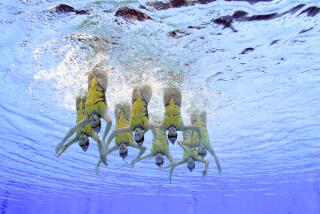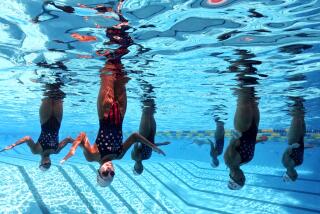THE WATER WORKS
Hey, swimmers, don’t limit yourself to lanes, the aquatic version of a hamster wheel.
And landlubbers, give up the notion that strength training and cardio are best done on terra firma.
Aqua aerobics, or aquatic fitness, is no longer the domain of people recovering from injuries, trying to exercise despite limited abilities or struggling with chronic conditions such as arthritis.
Pool workouts are hot, especially group exercise classes. The latest ones incorporate Pilates, kickboxing and strength training, targeting all muscle groups and building endurance.
“Working out in the water is excellent cross-training,” says Julie Seamster, an aquatic fitness instructor at California Family Fitness in Sacramento. “On land you’re using gravity, but in water you’re using the water’s properties -- it’s heavier than air, and you have resistance in all directions.”
Water also provides bones and joints with a break from constant pounding -- a big boon for those who run or play sports such as soccer, volleyball and basketball. “You can exercise at a high intensity with zero impact,” says Niecia Staggs, a masters swim coach at Equinox.
“You also have the challenge of maintaining core stability,” says Doris Dodge-Thews, a master trainer with 24-Hour Fitness. “Any time you’re in water, you challenge the core to maintain any movement.” Water’s constant motion forces the body to stay upright and balanced, which targets the muscles in the trunk and back.
Obviously, already-fit types looking for new challenges, especially as summer approaches, should think twice before passing on the opportunity to work out while staying cool.
We asked four aquatic fitness experts for their favorite pool exercises that can be added to lane swims, or done on their own. While most of these can be tackled by water workout novices, they’re not necessarily for the faint of heart. Many trainers recommending taking a couple of group classes to get a feel for proper form. Some exercises require minimal equipment, such as small, hand-held buoys or water noodles, which can be found at most sporting goods stores or online.
Niecia Staggs
Masters swim coach, Equinox, Southern California:
1. For a good cardio exercise that gets the blood flowing and also works the leg muscles, begin by resting your arms on a water noodle placed around your back in a C-shape. Bend your body at the hips in a V, so the feet are up at the surface. Make sure your core is tight, and legs are straight with toes pointed. Holding tension in the leg muscles, cross the feet back and forth at the ankles, just below the surface of the water. Do it as briskly as you can. The water provides resistance. Start with 1 1/2 minutes and gradually work up to about five minutes.
2. While still in that V position, do leg sweeps. Keep the right leg straight and push the toes toward the left hand, then reverse it -- take the left foot over to the right hand. You’ll feel it in the core, but this also targets the quadriceps, hamstrings and glutes, similar to a kicking exercise. You may not be able to take your foot all the way to your hand, but strive for increasing your range of motion. Even if you don’t have full range of motion to start, you’ll still feel it. Do about 12 to 16 reps on each leg.
3. Deck push-ups are great for the shoulders, back and arms. Stand by the side of the pool facing the pool’s edge, with hands shoulder-width apart, about chest-high on the deck. Push down through the palms and, with a little jump, come out of the water so that your hips are even with the deck. Hold that position for a couple of seconds, and then lower down slowly.
Doris Dodge-Thews
Master trainer, 24 Hour Fitness, Orange County:
1. To give your abs a workout, place a noodle along your back and rest your arms on it. Let your feet dangle in the water, fully extended. Bring the knees up to the chest, feeling the move in your core. Everything has to fire to make that exercise happen. To change it up, rotate the knees toward the shoulders as you bring them up, which will target the obliques. Do three sets of 25 reps.
2. This exercise uses buoys to work the obliques and back extensors: Stand in chest-high water with legs shoulder-width apart. Holding a buoy in each hand, bend to the left and take the buoy toward the knee. This forces the obliques to contract, and works the back extensors. Resist the movement on the way up, and do the same thing on the other side. Do 20 repetitions on each side.
3. Another good move that targets the hip flexors, glutes, quads, and inner and outer thigh muscles is called a clam digger. With the noodle behind your back, lie on it with arms extended, and angle your body to one side. With knees together, one on top of the other, bend the legs. Keeping the feet together, open the top knee, then bring knees together again. Flip over and do the same on the other side. Repeat 20 times on each side.
Katina Brock
Water aerobics instructor, North Valley Family YMCA, Northridge:
1. For a cardio boost, try tuck jumps. Start by having your feet on the bottom of the pool, water about chest-high. Push off the bottom and go into a tuck position, bringing your hands to your shins, like you’re doing a cannonball. If you pull your arms down hard, you’ll feel it. Then release the arms as the feet shoot down to the bottom. It’s better to do this quickly -- don’t rest on the return -- to get your heart rate up. A quicker tempo will work the legs more too. To make this move more difficult, start with one leg lifted in the tuck position and alternate legs coming up into the tuck position instead of both coming up at the same time. Consider this interval training -- do it for a minute or two minutes, gradually increasing the time.
2. Jumping jacks are also good for cardio and working major leg muscles. Start with your feet together, touching the bottom of the pool, arms by your side, water about mid-chest-high. Jump out so the feet are wide, and the arms come up straight out to the side. Jump back to a standing position, and repeat, but don’t land stiff-legged -- land with some softness in the knees to absorb the small amount of impact to the legs.
3. For a faux cycling workout, put the noodle between your legs for buoyancy and move your legs as if you were pedaling. You can move your arms in a breast stroke or a paddling motion, and even cycle backward. Add some visual imagery to it too -- pretend you’re in a group cycling class and lean back like you were going uphill, or lean forward slightly as on a downhill. Even if you are a cyclist, by doing this in the water you’ll be using some slightly different muscle groups. It’s just different enough, but it allows you to keep or improve your training endurance and skills.
Julie Seamster
Aquatic fitness instructor, California Family Fitness, Sacramento:
1. Jogging in the water is great for improving cardio, and the legs work while moving against the water. Try jogging in shallow water that comes up to between your belly button and chest. As you jog, do a reverse breast stroke, in which your arms are coming in toward each other, so you’re kind of hugging the water. Gather as much water as possible while running forward. You’ll be resisting the water as you travel forward, which will impede your travel. Jog forward for about 16 counts, then go backward doing a regular breast stroke, which will impede your travel again. This helps to improve cardiovascular function and endurance. If trying this in the ocean, travel laterally so that the water level stays the same.
2. For the upper body, do bicep curls using hand-held buoys. With palms facing up and the buoy on the water’s surface, bring the buoy down, keeping the elbow steady and by your side. This exercise also targets the triceps -- when you pull down, you’ll feel it in the back of the arm. Let the buoy up slowly. Do about eight to 12 reps for a couple of sets. Whenever you use buoyant equipment in this way, take precautions with your shoulder and neck. Holding the buoy, there’s a tendency to raise your shoulders up toward your ears, but your shoulders should be kept pressed down.
3. To work the core, stand in a squat position with both feet touching the ground and knees bent. The water should be about chest-high. Work the water with the upper body, scooping it with palms up, like you’re rowing a boat. You can do this with arms in unison, or alternating them. Squeeze the glutes and contract your abs and keep the core strong as you work the water with your hands. Do this in intervals, starting with 20 seconds, gradually increasing it to 45 seconds.
--


